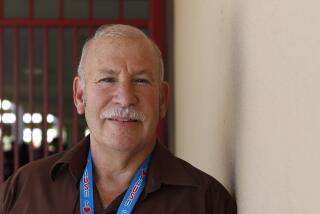Hertzberg’s Vision for Education
- Share via
Behind his repeated calls to break up the Los Angeles Unified School District, mayoral candidate Bob Hertzberg envisions a new system that would give the mayor substantial control over the schools and could result in a single district encompassing the entire city.
That idea comes in stark contrast to the way the long-running debate over dismantling the nation’s second-largest school district has been framed. Past supporters of breaking up the district had called for much smaller school systems that would be more responsive to parents and community leaders.
But in a recent interview, Hertzberg made clear that he believes the mayor must have control over the school system and that the size of the new district is secondary.
He said one way to reorganize would be to pare away the smaller cities and other communities within the district, giving it the same boundaries as its namesake city. That would yield a district of nearly 600,000 students, which would still be second in size only to New York City’s.
“I just don’t think you can run the city without” having control over the schools, Hertzberg said, noting that the mayors of New York and Chicago already have significant influence over their public education systems. He lambasted Los Angeles Unified as “just impossible to deal with” and a “big fat roadblock.”
Yet Hertzberg’s breakup call comes at a time when Los Angeles elementary schools’ test scores are rising and the district has embarked on a $14-billion school building program to reduce overcrowding.
Hertzberg, a former Democratic speaker of the California Assembly, has made splitting the school district an unlikely hallmark of his campaign for mayor, an office that has no official role in local education. Republican Gov. Arnold Schwarzenegger said last week the Los Angeles district was “too big and inefficient,” potentially boosting Hertzberg’s efforts.
In contrast, Hertzberg’s proposal to downsize the 746,000-student district has been derided or ignored by his four main rivals in the mayoral race. Their ideas about improving education, which include expanding city-run after-school programs and improving campus safety, would not infringe on the district’s autonomy.
“We need to improve [student] performance, not get distracted with some complicated breakup plan,” said Mayor James K. Hahn, who is running for reelection March 8.
Breakup opponents and others dismiss Hertzberg’s call as a purely political gambit to tap voter dissatisfaction with the schools, especially in the San Fernando Valley, where secession efforts have failed. A Times poll earlier this month found 57% of registered voters in favor of breaking up the district, with 25% opposed; support for a breakup was strongest among whites and in the Valley.
In his speeches and ads, Hertzberg has refused to offer specifics about his breakup plans. When pressed, he said he wants to create a task force to deal with most of the details -- when and if he is elected.
“I have no clue if he’s serious,” said former Republican Assemblywoman Paula Boland, who worked for years to allow the San Fernando Valley to separate from the district.
“He hasn’t talked to me about it.”
Political strategist Rick Taylor, who is not working for any of the mayoral candidates, said Hertzberg has tapped into an issue of major concern to many voters.
“He has no jurisdiction and no plan, but it’s great politics,” Taylor said. “ ‘Let’s break it up’ sounds good.”
Hertzberg acknowledged he would need the Legislature’s cooperation to create new districts for the more than two dozen communities that would be lopped from L.A. Unified, including Cudahy, Gardena, Huntington Park, Lomita, Maywood, San Fernando and West Hollywood.
He said he would probably skip the current reorganization process -- which places power in the hands of the appointed state Board of Education -- and instead push for a state ballot initiative that could prohibit cities with more than 2 million people from having a school district exceeding municipal boundaries.
The proposal to split off the Valley, which failed in late 2001 when the state board refused to allow a vote on it, called for two Valley districts of about 100,000 students each. And when businessman Steve Soboroff ran unsuccessfully for mayor four years ago, he called for Los Angeles Unified to be split into at least 20 smaller districts.
Hertzberg has given the impression that he, too, favors smaller districts. When he first called for dismantling the district in early December, his campaign press release had him advocating “small, neighborhood school districts.” In his recent television commercial, he promises to “break it up into smaller districts for local control and better schools.”
And on his Website, www.changela.com, he discusses at length “neighborhood districts” and the benefits of creating “many new, smaller districts.” Only in the last paragraph, as one of many ideas, does he allude to “just breaking off the part of the district that’s within the city of L.A. and putting it under mayoral control.”
In the Times interview, Hertzberg would not speculate on whether there should be numerous small districts.
“I’m not prepared to make that decision at this point,” Hertzberg said. “I just don’t know.”
Even creating a single city district would pose thorny problems, including classroom space.
A Times computer analysis showed that the West Valley and Westside currently have a combined excess of 30,000 classroom seats, while the Eastside and South L.A. are about 31,000 seats short. The district has dealt with those disparities by taking the unpopular or expensive steps of placing crowded schools on year-round schedules and busing students to campuses with empty seats.
In addition, a Los Angeles-only school district would leave a classroom shortage in the small cities southeast of Los Angeles, including Huntington Park and South Gate. The Times analysis showed that nearly 14,000 more L.A. Unified students live in those cities than there are seats in the schools there, even with the campuses operating year-round.
The district’s current building program will reduce but not eliminate the classroom shortages. The Times analysis projected that a sizable imbalance will remain through 2009, when the current building program will be three years from completion.
Hertzberg, while acknowledging that whittling the district and bringing it under city jurisdiction could take several years, insisted that the difficulties should not deter the effort.
“I want to force a discussion,” Hertzberg said. “My objective is not [a plan] wedded in stone to say this is what you have to do. My objective is to use the power of the mayor’s office to help make schools work better.”
Stephanie Carter, a leader with Boland in the failed Valley breakaway bid, said it didn’t bother her that Hertzberg did not support her group’s efforts.
“Everybody is entitled to change their mind,” Carter said, adding that she supports Hertzberg and is pleased to see the breakup “in play again” in the mayoral race.
Richard Riordan brought his longtime interest in school reform to the mayor’s office when he first won election in 1993. In the 2001 race to replace him, schools became a major issue.
This time -- except for Hertzberg’s breakup call -- education appears to have taken a back seat to crime, traffic and ethics concerns, despite polls showing that schools are still important to voters. When the candidates discuss schools, they describe a mostly supporting role for the city.
Hahn cites an education record that includes expansion of the well-regarded L.A.’s Best after-school program; the founding of Cash for College, which finds scholarships for high school seniors; and his work with businesses on enrichment programs. He added a school facilities division to the mayor’s office to help the district build new campuses and to promote agreements that allow greater community use of school facilities.
Councilman Antonio Villaraigosa, who is married to a teacher, cites his efforts to help pass facilities bond measures and other school-related legislation when he was speaker of the Assembly. He has also worked to help open charter schools in his district.
“Rather than point fingers, I want to partner with the school district,” said Villaraigosa, who will soon announce his education proposals.
“The mayor of this city has to work with [the district] to rethink how to best bridge the achievement gap” that keeps black and Latino students lagging behind.
Councilman Bernard C. Parks, the former police chief, cautioned against “trying to find quick, overnight solutions” to the district’s problems. He said the district has made significant strides in curriculum and student achievement and in adding full-day kindergarten.
As mayor, he said, he would help the schools make better connections with business and community members. “That’s the area where they are most deficient,” Parks said.
State Sen. Richard Alarcon, a former teacher and city councilman, said he would work with the school district to “reduce the bureaucracy” but would not support dismantling the district.
“The mayor and the city have a responsibility to embellish the educational program,” Alarcon said.
Among other ideas, he would place computer learning labs in every park recreation center and offer city programs to help residents with limited English proficiency master the language.
Times researcher Maloy Moore contributed to this report.
More to Read
Sign up for Essential California
The most important California stories and recommendations in your inbox every morning.
You may occasionally receive promotional content from the Los Angeles Times.












